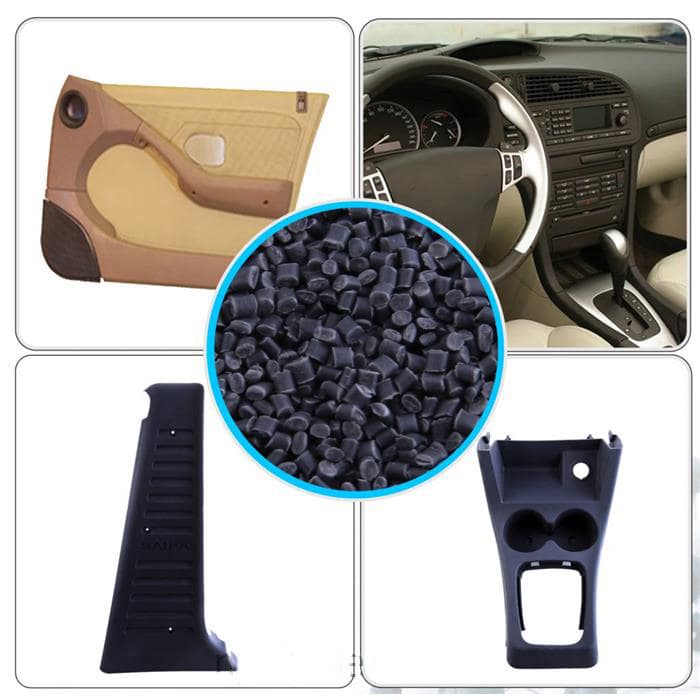Compound PP / PE / ABS
This product of this company is produced from recycled based on the customer’s order based on polypropylene and polyethylene in the form of self-color. This product is used in the industries of tank production, household appliance production, packaging parts production, and pipe and fittings production.
Features of PP / PE compounds


Advantages
Nirocalcite includes products based on polyethylene and polypropylene, which are produced according to customer needs in different grades along with calcium carbonate filler. The use of calcium carbonate filler in these products, in addition to maintaining the mechanical and appearance properties, reduces the price of these products.
applications
This product is used in packaging industries, household appliances, sanitary appliances, horticulture, agriculture, etc. By using mineral filler, this product can be introduced as an environmentally friendly product.
Advantages of using calcium carbonate filler in polyethylene and polypropylene products
The use of calcium carbonate filler in polyethylene and polypropylene products provides several advantages:
- Cost reduction: Calcium carbonate filler is less expensive than the base polymer, so its use reduces the overall cost of the product.
- Improved mechanical properties: Calcium carbonate can improve the stiffness and strength of the material, which can lead to better mechanical properties of the final product.
- Enhanced appearance: Calcium carbonate filler can improve the appearance of the material by increasing its opacity, brightness, and whiteness.
- Environmental benefits: The use of calcium carbonate filler can reduce the amount of polymer required in the product, which can result in lower greenhouse gas emissions and energy consumption during production. Additionally, calcium carbonate is a naturally occurring mineral and can be sourced from renewable resources.
Overall, the use of calcium carbonate filler in polyethylene and polypropylene products can provide cost savings, improved mechanical properties, enhanced appearance, and environmental benefits.
pvc compound
PVC (Polyvinyl Chloride) compound is a mixture of PVC resin and various additives such as plasticizers, stabilizers, lubricants, and pigments. PVC compounds are widely used in the production of a variety of plastic products including pipes, cables, profiles, flooring, and packaging materials.
The PVC resin used in the compound is a thermoplastic polymer that is made from the monomer vinyl chloride. The additives used in the compound are added to improve the properties of the PVC resin such as its flexibility, durability, and resistance to heat, chemicals, and UV radiation.
Plasticizers are added to make the PVC compound flexible and soft, while stabilizers are added to prevent the PVC from breaking down due to exposure to heat, light, or chemicals. Lubricants are added to improve the flow properties of the PVC during processing, while pigments are added to give the PVC compound its desired color.
PVC compounds can be customized to meet specific requirements such as flame retardancy, electrical conductivity, and low-temperature flexibility. They can be processed using various methods such as extrusion, injection molding, and calendering to produce a wide range of products.
All kinds of compounds pvc
The compound material is suitable for use in various industries, such as tank production, household appliance production, packaging parts production, and pipe and fittings production. It is a versatile material that can be molded or extruded into different shapes and sizes, making it useful for a wide range of applications.
Using recycled materials in the production of the compound is an environmentally friendly approach that reduces waste and conserves resources. It is an excellent example of sustainable manufacturing practices that can benefit both the company and the environment.
polypropylene (PP) and polyethylene (PE) are both thermoplastics commonly used in the manufacturing of various products due to their durability, versatility, and resistance to chemicals and moisture. ABS is another thermoplastic known for its high impact resistance and toughness, making it suitable for applications where strength and durability are essential.
By combining these three plastics in a compound material, the resulting product can offer enhanced properties that are suitable for a wide range of applications. For example, the addition of ABS to the PP and PE can increase the material’s impact resistance and strength, making it suitable for use in tank production and other applications that require materials that can withstand wear and tear.
The fact that this product is made from recycled materials is also worth noting. Recycling plastics is an important step in reducing waste and conserving resources. By using recycled plastics in the production of new products, we can reduce the amount of plastic waste that ends up in landfills or oceans and conserve the resources required to produce new plastics from scratch.
In conclusion, the production of a compound material made from recycled PP, PE, and ABS plastics is a sustainable and versatile solution that can benefit both the manufacturer and the environment. Its applications in various industries make it a valuable material that can be customized to meet specific needs and requirements.
